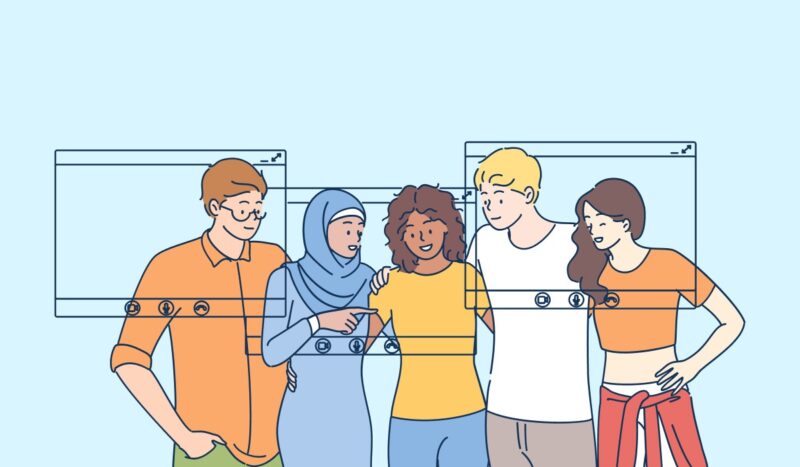In a world where cultural divides once depended on geography, language, and access, online platforms now serve as the most effective tools for closing those gaps. The concrete answer is simple: technology has turned cultural distance into digital proximity.
Through social media, video conferencing, language apps, and global chat networks, people from vastly different backgrounds interact daily, sharing values, humor, art, and real-time opinions that would have once been confined to borders.
The internet is no longer just a medium of communication; it’s a living space where cultures meet, mix, and evolve.
The Rise of Digital Cross-Cultural Interaction

Before digital platforms, cultural exchange required travel, education programs, or formal institutions. Today, it happens naturally often between strangers.
A teenager in Serbia can discuss music trends with a student in South Korea on Discord, while an artist in Brazil can collaborate with a designer in Japan through Behance.
These aren’t isolated cases. According to data from Statista, over 5.3 billion people were active internet users by 2025, meaning that the majority of the world’s population participates in at least one form of cross-cultural exchange daily.
The internet has democratized cultural access. Instead of depending on mainstream media, individuals now discover authentic, firsthand experiences directly from people around the world.
YouTube, TikTok, and Reddit have become cultural classrooms, not because they were designed for it, but because users turned them into open dialogue spaces. The result is a constant blending of identities and ideas.
How Online Platforms Make Cultural Exchange Accessible
Digital spaces operate on one key principle: inclusivity. Unlike physical communities, where cultural exchange can be limited by location or social circles, online platforms open participation to anyone with a connection.
This accessibility transforms communication into cultural learning.
Here’s how it works in practice:
| Platform Type | Cultural Function | Example of Exchange |
| Social Media | Promotes daily exposure to other cultures through shared content | Users learn traditions through viral challenges, memes, or cultural holidays |
| Video Calls and Chat Platforms | Enable real-time dialogue between individuals from different backgrounds | Students use apps to practice foreign languages with native speakers |
| Content Collaboration Tools | Allow international creative teamwork | Artists co-design across time zones using shared cloud platforms |
| Gaming Communities | Build global microcultures with shared values and communication norms | Players cooperate and negotiate cultural dynamics in multiplayer games |
Platforms like CallMeChat take this even further by focusing specifically on cross-cultural connections. Instead of algorithms that prioritize content similarity, they promote open dialogue between people with different perspectives.
This direct peer-to-peer communication makes it easier for users to move beyond stereotypes and gain real insight into how others think, work, and live.
In that sense, these chat-driven networks are modern cultural bridges, fostering empathy and curiosity in real time.
Language as a Gateway and a Barrier Overcome

Language has historically been one of the strongest cultural dividers. Online platforms have reduced this obstacle dramatically.
Tools like Google Translate and Duolingo make it possible for people to engage across languages, while multilingual interfaces have become the standard on nearly every major app.
But translation alone doesn’t explain the full picture. Online culture now operates through shared symbols, emojis, memes, GIFs, and reaction videos.
These new “digital languages” function independently of words, carrying emotional and cultural meaning that anyone can understand. For instance, the “facepalm” emoji or a “laughing cat” meme communicates universal emotions that transcend linguistic boundaries.
As cultural semiotics evolve online, younger generations learn to interpret humor, sarcasm, and empathy across borders without even realizing it.
This form of passive cultural learning is one of the internet’s most underrated impacts.
The Double-Edged Nature of Global Connection
While online communication fosters understanding, it also reveals tension.
Exposure to different cultural norms can lead to friction or misunderstanding. Misinterpreted gestures, humor, or political views can create conflict just as easily as connection.
However, the digital environment provides a unique corrective mechanism for dialogue. In forums, chats, and comment sections, users can challenge one another’s views, clarify meanings, and eventually find shared ground.
The more people interact with diverse perspectives, the more flexible their worldview becomes.
In 2025, many global organizations will be using online collaboration to promote cultural literacy. UNESCO, for example, supports digital exchange projects that link classrooms across continents, while independent platforms host multilingual podcasts and discussion groups designed to increase cultural empathy.
These small-scale digital communities are shaping a generation that views diversity not as an obstacle, but as a foundation for growth.
Where Technology Meets Culture: Real-World Impacts
Online platforms are not just social tools; they are cultural ecosystems that affect how we work, learn, and express identity.
- Education
Cross-border virtual classrooms and exchange programs allow students to experience other cultures without leaving their country. Universities now use collaborative tools and forums where students analyze global issues together. - Business
Remote work and international freelancing have made intercultural communication a daily skill. A single video call can now include voices from four continents. Platforms like Slack and Zoom normalize global teamwork, encouraging respect for time zones, languages, and communication styles. - Social Movements
Hashtags and digital campaigns create cultural solidarity. Movements for human rights, environmental awareness, and equality spread globally within hours, illustrating how shared digital narratives can unify people who might otherwise never meet. - Creative Industries
From music collaborations between continents to online art exhibitions, creativity has become borderless. Artists merge regional influences, producing hybrid genres that redefine traditional identities.
The Human Side of Connection

At the heart of digital cultural exchange lies something deeply human: the desire to be understood.
Online platforms give individuals the rare opportunity to present their authentic selves to a global audience. For many, especially in underrepresented regions, this is a form of empowerment.
For example, local creators from Africa, South America, and Southeast Asia are now influencing global fashion and music trends through short-form content and storytelling. Cultural ownership has shifted from corporations to individuals.
The digital landscape no longer mirrors Western dominance but increasingly reflects a polycentric world where every voice contributes to the cultural mosaic.
The Future of Cultural Connectivity
The next phase of online cultural exchange will be driven by AI translation, virtual reality, and immersive social spaces.
Already, AI is making real-time multilingual communication seamless. VR platforms will soon allow users to experience cultural landmarks and festivals virtually, learning traditions by participation rather than observation.
But as the technology advances, the core goal remains unchanged: human understanding.
The internet is not erasing cultural differences; it is teaching people to appreciate them. Online platforms have turned the idea of “meeting halfway” into something literal: a digital meeting point where all cultures can coexist, communicate, and evolve together.
Conclusion
Online platforms bridge cultural gaps by creating environments where exposure leads to understanding.
The concrete takeaway is that technology alone doesn’t unite people; communication does. Apps, chat platforms, and global communities give that communication a stage.
As tools like CallMeChat continue to connect diverse users directly, cultural awareness stops being an abstract goal and becomes a daily experience.

